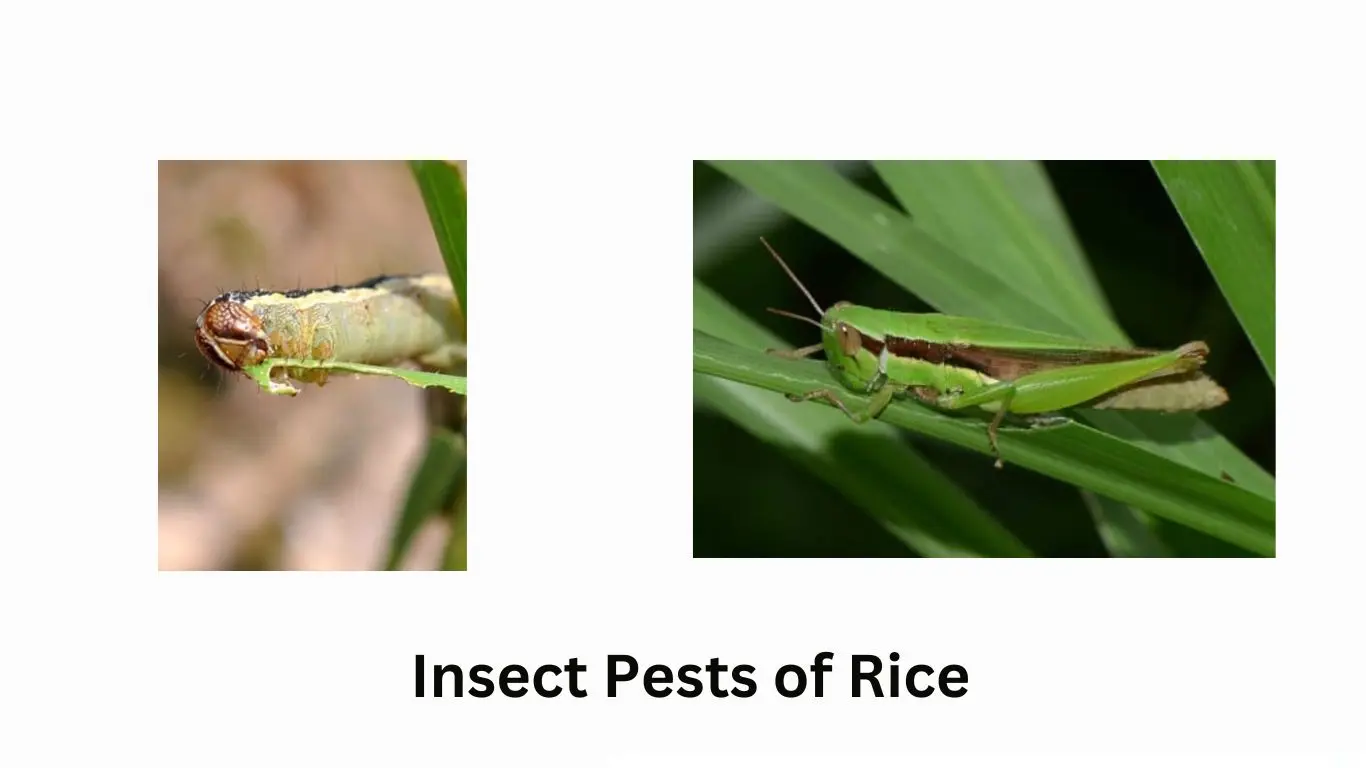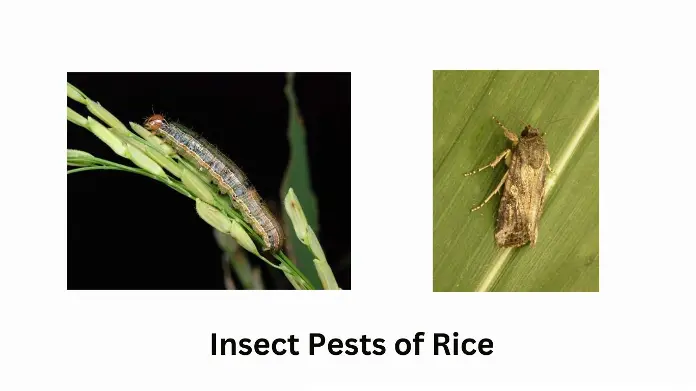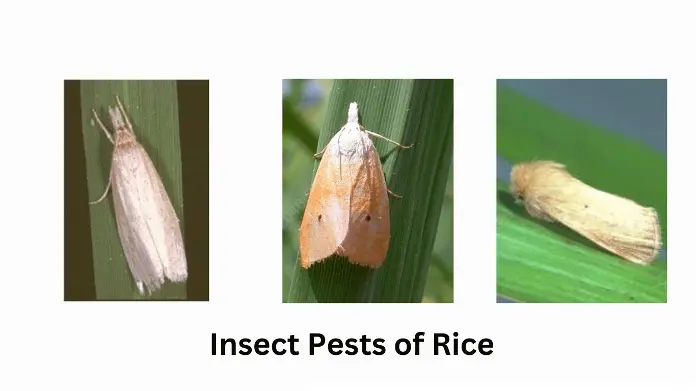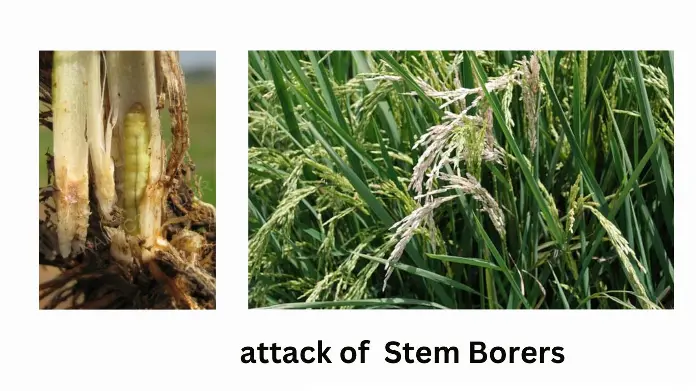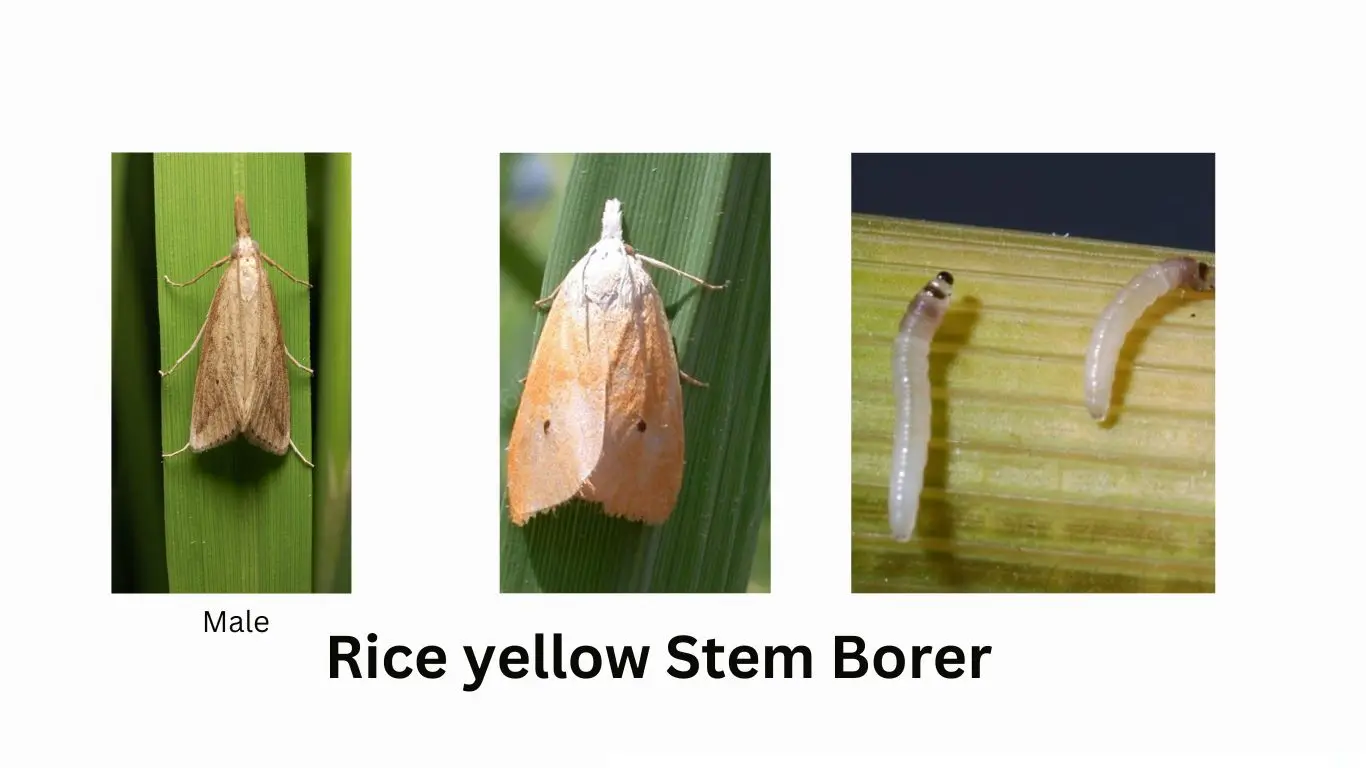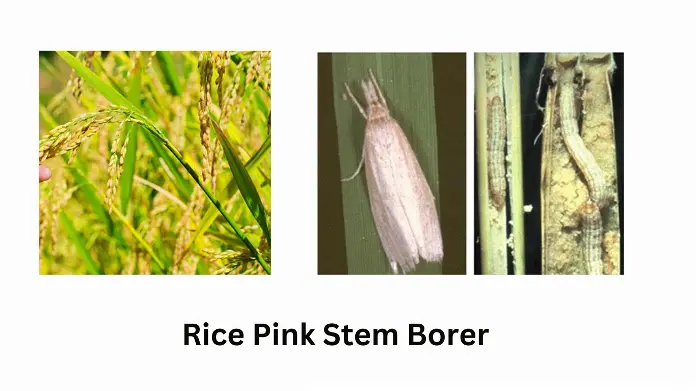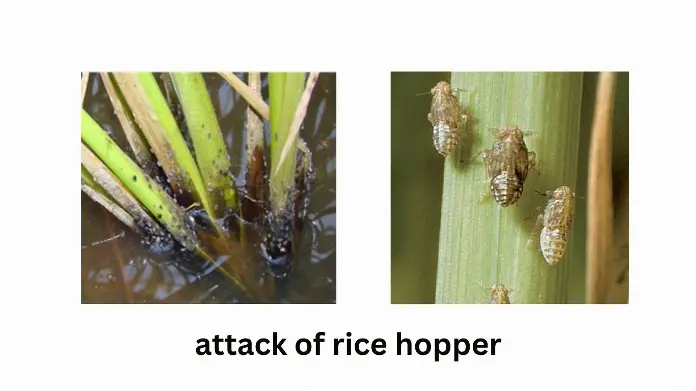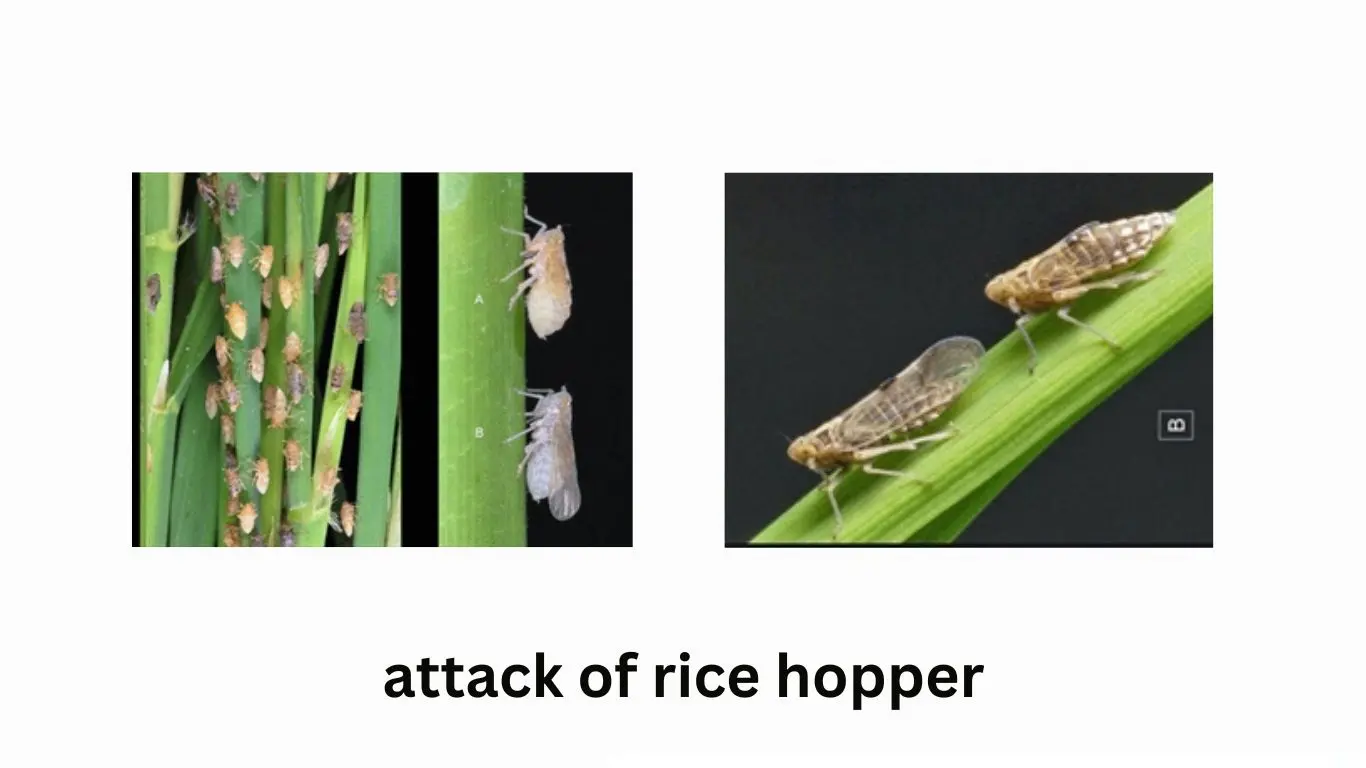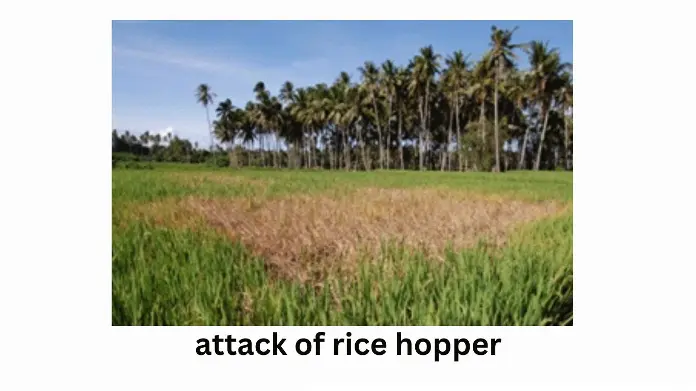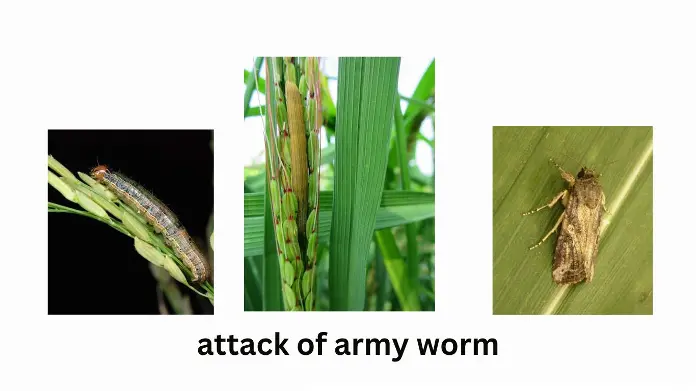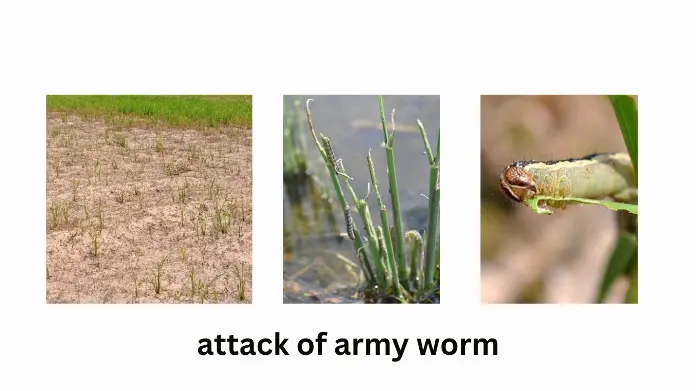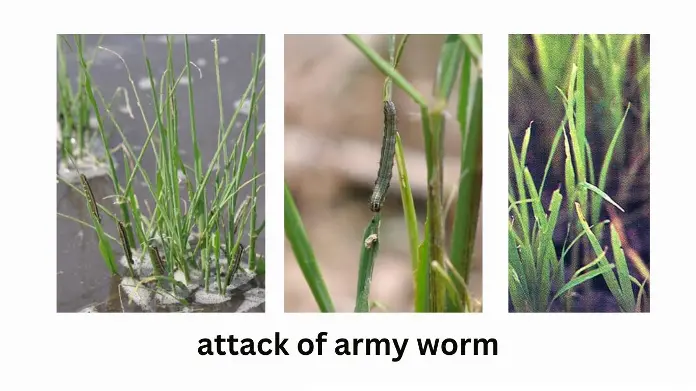RICE INSECT PESTS AND THEIR CONTROL
Introduction to Insects Pests of Rice
Pests that affect paddy crops include the Leafhopper, White-backed Weevil, and Brown Beetle, all of which pose significant threats to the health of the plants. Among the various pests, Stem Borers are particularly aggressive towards Basmati varieties, while Leaffolders exhibit similar levels of aggression towards both Aari and Basmati types. The White-backed Teela tends to be more harmful to Aari varieties, but in their absence, it will also target Basmati crops. Additionally, the Toka, a type of grasshopper, inflicts damage on both the yield and quality of paddy. The Black Bhondi, or Hispa Rice, is another pest that attacks paddy, while the Lashkari Sundi is less common but can cause severe damage when it does occur.The impact of Stem Borers on paddy crops, especially Basmati varieties, is noteworthy. Yellow and white borers are responsible for more significant damage compared to their pink counterparts, which are less harmful. These pests overwinter in the larval stage within paddy fields, where they reside in the roots. As the season progresses into late March or early April, the larvae undergo metamorphosis into pupae, eventually emerging as butterflies that threaten subsequent crops.The feeding behavior of these borers is particularly detrimental, as they enter the stems and consume the internal tissues, leading to a condition known as "soak or dead heart." This results in the formation of whiteheads, where the spikes fail to produce grains, severely affecting the overall yield. Understanding the life cycle and control measures for these pests is crucial for effective management and protection of paddy crops.
دھان کی فصلوں کو متاثر کرنے والے کیڑوں میں Leafhopper، White-backed Weevil، اور Brown Beetle شامل ہیں، یہ سب پودوں کی صحت کے لیے اہم خطرہ ہیں۔ مختلف کیڑوں میں سے، تنے کی جڑیں باسمتی کی اقسام کے لیے خاص طور پر جارحانہ ہیں، جبکہ لیفولڈرز آڑی اور باسمتی دونوں اقسام کے لیے یکساں سطح کی جارحیت کا مظاہرہ کرتے ہیں۔ سفید پشت والا تیلہ آڑی کی اقسام کے لیے زیادہ نقصان دہ ہوتا ہے، لیکن ان کی غیر موجودگی میں یہ باسمتی کی فصلوں کو بھی نشانہ بنائے گا۔ مزید برآں، ٹوکا، ٹڈڈی کی ایک قسم، دھان کی پیداوار اور معیار دونوں کو نقصان پہنچاتی ہے۔ کالا بھونڈی، یا ہسپہ چاول، ایک اور کیڑا ہے جو دھان پر حملہ کرتا ہے، جبکہ لشکری سندھی کم عام ہے لیکن جب یہ ہوتا ہے تو شدید نقصان پہنچا سکتا ہے۔ دھان کی فصلوں، خاص طور پر باسمتی کی قسموں پر تنے کی بورز کا اثر قابل ذکر ہے۔ پیلے اور سفید بوررز اپنے گلابی ہم منصبوں کے مقابلے میں زیادہ اہم نقصان کے ذمہ دار ہیں، جو کم نقصان دہ ہیں۔ یہ کیڑے دھان کے کھیتوں میں لاروا کے مرحلے میں موسم سرما میں رہتے ہیں، جہاں یہ جڑوں میں رہتے ہیں۔ جیسے جیسے موسم مارچ کے آخر یا اپریل کے شروع میں آگے بڑھتا ہے، لاروا pupae میں میٹامورفوسس سے گزرتا ہے، آخر کار تتلیوں کے طور پر ابھرتا ہے جو بعد میں آنے والی فصلوں کو خطرہ بناتا ہے۔ ان بوروں کا کھانا کھلانے کا رویہ خاص طور پر نقصان دہ ہوتا ہے، کیونکہ یہ تنوں میں داخل ہوتے ہیں اور اندرونی بافتوں کو کھا جاتے ہیں، جس سے ایسی حالت جسے "سوک یا مردہ دل" کہا جاتا ہے۔ اس کے نتیجے میں وائٹ ہیڈز بنتے ہیں، جہاں سپائیکس اناج پیدا کرنے میں ناکام رہتے ہیں، جس سے مجموعی پیداوار بری طرح متاثر ہوتی ہے۔ ان کیڑوں کے لائف سائیکل اور کنٹرول کے اقدامات کو سمجھنا دھان کی فصلوں کے موثر انتظام اور تحفظ کے لیے بہت ضروری ہے۔
Types of insects pest of Paddy
Paddy crops are susceptible to various pests, including the Leafhopper, White-backed Weevil, and Brown Beetle, all of which significantly threaten plant health. Among these, Stem Borers are particularly aggressive towards Basmati rice varieties, while Leaffolders show comparable levels of aggression towards both Aari and Basmati types. The White-backed Teela is especially harmful to Aari varieties, but in the absence of Aari, it will also target Basmati crops. Furthermore, the Toka, a species of grasshopper, damages both the yield and quality of paddy. The Black Bhondi, also known as Hispa Rice, is another pest that affects paddy, while the Lashkari Sundi, though less common, can inflict severe damage when present.
دھان کی فصلیں مختلف کیڑوں کے لیے حساس ہوتی ہیں، جن میں لیف ہاپر، وائٹ بیکڈ ویول، اور براؤن بیٹل شامل ہیں، یہ سبھی پودوں کی صحت کے لیے نمایاں طور پر خطرہ ہیں۔ ان میں سے، تنوں کے خنجر باسمتی چاول کی اقسام کے لیے خاص طور پر جارحانہ ہوتے ہیں، جبکہ لیفولڈرز آڑی اور باسمتی دونوں اقسام کے لیے جارحانہ سطح کا موازنہ کرتے ہیں۔ سفید پشت والا تیلہ خاص طور پر آڑی کی اقسام کے لیے نقصان دہ ہے لیکن آڑی کی عدم موجودگی میں یہ باسمتی کی فصلوں کو بھی نشانہ بنائے گا۔ مزید برآں، ٹوکا، ٹڈڈی کی ایک قسم، دھان کی پیداوار اور معیار دونوں کو نقصان پہنچاتی ہے۔ کالی بھونڈی، جسے ہسپا چاول بھی کہا جاتا ہے، ایک اور کیڑا ہے جو دھان کو متاثر کرتا ہے، جبکہ لشکری سنڈی، اگرچہ کم عام ہے، موجود ہونے پر شدید نقصان پہنچا سکتی ہے۔
Influence of Stem Borers on Rice
The influence of Stem Borers on paddy crops, particularly Basmati varieties, is significant. Yellow and white borers tend to cause more extensive damage than their pink counterparts, which are relatively less harmful. These pests overwinter in the larval stage within the paddy fields, residing in the roots. As the season transitions into late March or early April, the larvae metamorphose into pupae, ultimately emerging as butterflies that pose a threat to subsequent crops.The feeding habits of these borers are particularly harmful, as they penetrate the stems and consume the internal tissues, resulting in a condition referred to as "soak or dead heart." This leads to the development of whiteheads, where the spikes fail to produce grains, severely impacting overall yield. A comprehensive understanding of the life cycle and effective control measures for these pests is essential for the successful management and protection of paddy crops.
دھان کی فصلوں، خاص طور پر باسمتی کی اقسام پر تنوں کے تنوں کا اثر نمایاں ہے۔ پیلے اور سفید بوررز اپنے گلابی ہم منصبوں کے مقابلے میں زیادہ وسیع نقصان پہنچاتے ہیں، جو نسبتاً کم نقصان دہ ہوتے ہیں۔ یہ کیڑے دھان کے کھیتوں میں لاروا مرحلے میں سردیوں میں رہتے ہیں، جڑوں میں رہتے ہیں۔ جیسے جیسے موسم مارچ کے آخر میں یا اپریل کے شروع میں تبدیل ہوتا ہے، لاروا pupae میں تبدیل ہو جاتا ہے، بالآخر تتلیوں کے طور پر ابھرتا ہے جو بعد میں آنے والی فصلوں کے لیے خطرہ بنتا ہے۔ ان بوررز کے کھانے کی عادتیں خاص طور پر نقصان دہ ہوتی ہیں، کیونکہ یہ تنوں میں گھس کر اندرونی بافتوں کو کھا جاتے ہیں، اس کے نتیجے میں ایک ایسی حالت ہوتی ہے جسے "سوک یا مردہ دل" کہا جاتا ہے۔ یہ وائٹ ہیڈز کی نشوونما کا باعث بنتا ہے، جہاں سپائیکس اناج پیدا کرنے میں ناکام رہتے ہیں، جس سے مجموعی پیداوار پر شدید اثر پڑتا ہے۔ دھان کی فصلوں کے کامیاب انتظام اور تحفظ کے لیے زندگی کے چکر اور ان کیڑوں کے لیے موثر کنٹرول کے اقدامات کی ایک جامع تفہیم ضروری ہے۔
Managements of Stem Borers
To effectively manage stem borer infestations, it is essential to disrupt their lifecycle by plowing paddy fields until the end of February, thereby destroying the roots. Prior to April, it is advisable to remove any excess paddy plants to eliminate potential egg-laying sites for the moths. Additionally, cultivating paddy seedlings after May 20 is recommended, as moth populations are typically low during this period. When planting seedlings, it is crucial to avoid using soaked plants and to eliminate them instead. Regularly inspect the leaves for egg masses and remove them promptly. Furthermore, controlling weeds in and around the seedling fields is vital for reducing habitat for the pests. Implementing light traps at night can aid in monitoring moth activity, and trichogram cards should be placed on these traps when butterflies are present. For chemical control, the application of specific granular fertilizers is recommended, such as 8 kg of thiamethoxam combined with 4 kg of chlorantraniliprole per acre, or alternatively, 4 kg of Chlornetraniliprole alone, or a combination of /shop/cartap-hydrochloride-jaffer-cartap-hydrochloride-4-31406 cartap anand fipronil at 4.5 kg per acre. These treatments should be applied in standing water once the economic threshold for pest damage has been reached, and it is important to maintain standing water for a duration of 3 to 5 days to ensure effectiveness.Apply Branda, lambda cyhalothrin to control them..
تنے کی بورر کی افزائشوں کا مؤثر طریقے سے انتظام کرنے کے لیے ضروری ہے کہ فروری کے آخر تک دھان کے کھیتوں میں ہل چلا کر ان کے لائف سائیکل میں خلل ڈالیں، اس طرح جڑیں تباہ ہو جاتی ہیں۔ اپریل سے پہلے، دھان کے اضافی پودوں کو ہٹانے کا مشورہ دیا جاتا ہے تاکہ پتنگوں کے انڈے دینے کی ممکنہ جگہوں کو ختم کیا جا سکے۔ مزید برآں، 20 مئی کے بعد دھان کے بیج کاشت کرنے کی سفارش کی جاتی ہے، کیونکہ اس عرصے کے دوران کیڑے کی آبادی عام طور پر کم ہوتی ہے۔ پودے لگاتے وقت، بھیگے ہوئے پودوں کو استعمال کرنے سے گریز کرنا اور اس کی بجائے انہیں ختم کرنا بہت ضروری ہے۔ انڈے کے بڑے پیمانے پر پتوں کا باقاعدگی سے معائنہ کریں اور انہیں فوری طور پر ہٹا دیں۔ مزید برآں، پودوں کے کھیتوں میں اور اس کے آس پاس جڑی بوٹیوں کو کنٹرول کرنا کیڑوں کے لیے رہائش کو کم کرنے کے لیے بہت ضروری ہے۔ رات کے وقت روشنی کے پھندے لگانے سے کیڑے کی سرگرمیوں کی نگرانی میں مدد مل سکتی ہے، اور جب تتلیاں موجود ہوں تو ان جالوں پر ٹرائیکوگرام کارڈ لگائے جائیں۔ کیمیائی کنٹرول کے لیے، مخصوص دانے دار کھادوں کے استعمال کی سفارش کی جاتی ہے، جیسے کہ 8 کلوگرام تھیامیتھوکسام 4 کلو گرام کلورنیٹرانیلیپرول فی ایکڑ کے ساتھ ملا کر، یا متبادل طور پر، 4 کلو گرام کلورنیٹرینیلی پرول اکیلے، یا کارٹیپ اور فیپرونیل کا مرکب 4.5 کلوگرام فی ایکڑ۔ کیڑوں کے نقصان کے لیے اقتصادی حد تک پہنچنے کے بعد ان علاج کو کھڑے پانی میں لاگو کیا جانا چاہیے، اور تاثیر کو یقینی بنانے کے لیے 3 سے 5 دن تک کھڑے پانی کو برقرار رکھنا ضروری ہے۔
Rice Hopper
The rice hopper poses a significant threat to crops, particularly when they are in a dried state. This pest primarily targets healthy plants and can cause considerable damage. The initial signs of infestation often manifest as small wood chip-like formations. The adult hoppers, although diminutive in size, can proliferate rapidly. They typically emerge from the lower sections of the plant's stem, where they reproduce. The nymphs feed on the sap of the leaves and stems, leading to visible symptoms. Initially, the affected leaves exhibit browning, which can progress to a scorched appearance if the infestation is severe, resulting in the plants turning black and dry. This phenomenon is commonly referred to as burn or sole burn, with significant infestations often occurring around the second week of September, particularly affecting thicker rice varieties.
چاول کی چھڑی فصلوں کے لیے ایک اہم خطرہ ہے، خاص طور پر جب وہ خشک حالت میں ہوں۔ یہ کیڑا بنیادی طور پر صحت مند پودوں کو نشانہ بناتا ہے اور کافی نقصان پہنچا سکتا ہے۔ انفیکشن کی ابتدائی علامات اکثر لکڑی کی چھوٹی چپ جیسی شکل کے طور پر ظاہر ہوتی ہیں۔ بالغ ہوپر، اگرچہ سائز میں کم ہوتے ہیں، تیزی سے پھیل سکتے ہیں۔ وہ عام طور پر پودے کے تنے کے نچلے حصوں سے نکلتے ہیں، جہاں وہ دوبارہ پیدا ہوتے ہیں۔ اپسرا پتوں اور تنوں کے رس کو کھاتی ہے جس سے علامات ظاہر ہوتی ہیں۔ ابتدائی طور پر، متاثرہ پتے بھورے پن کی نمائش کرتے ہیں، جو کہ جھلسی ہوئی شکل اختیار کر سکتے ہیں اگر انفیکشن شدید ہو، جس کے نتیجے میں پودے سیاہ اور خشک ہو جاتے ہیں۔ اس رجحان کو عام طور پر برن یا سول برن کہا جاتا ہے، جس میں اہم انفیکشن اکثر ستمبر کے دوسرے ہفتے کے ارد گرد واقع ہوتے ہیں، خاص طور پر چاول کی موٹی اقسام کو متاثر کرتے ہیں۔
Managements
Effective management strategies for controlling rice hoppers include the elimination of weeds in and around the fields, as these can serve as hosts for the pests. Hand nets can be employed to collect and destroy the hoppers, while light traps set up in the fields during the night can effectively capture and kill the insect larvae. It is crucial to avoid standing water in the fields and to provide immediate intervention if an infestation is detected. Additionally, cultivating rice in shaded areas should be avoided, and the application of nitrogenous fertilizers should be carefully monitored to prevent unnecessary growth that may attract pests.For chemical control, it is recommended to apply Pi Metrozine at a dosage of 120 grams, or Chlothinadin at 200 ml, or a combination of Nitenpyram and Pi Metrozine at 100 grams per 100 liters of water. Granular insecticides should be applied in late September, taking into account the crop's condition, especially for Basmati varieties. Early intervention is critical to managing the rice hopper population effectively and ensuring the health of the crop.
چاول کے جھاڑیوں کو کنٹرول کرنے کے لیے موثر انتظامی حکمت عملیوں میں کھیتوں کے اندر اور اس کے آس پاس جڑی بوٹیوں کا خاتمہ شامل ہے، کیونکہ یہ کیڑوں کے لیے میزبان کے طور پر کام کر سکتے ہیں۔ ہاپروں کو جمع کرنے اور تلف کرنے کے لیے ہینڈ نیٹ کا استعمال کیا جا سکتا ہے، جبکہ رات کے وقت کھیتوں میں بچھائے جانے والے لائٹ ٹریپس کیڑے کے لاروا کو مؤثر طریقے سے پکڑ کر مار سکتے ہیں۔ کھیتوں میں پانی کھڑا ہونے سے گریز کرنا اور اگر انفیکشن کا پتہ چل جائے تو فوری مداخلت کرنا بہت ضروری ہے۔ مزید برآں، سایہ دار علاقوں میں چاول کی کاشت سے گریز کیا جانا چاہیے، اور نائٹروجن والی کھادوں کے استعمال کی احتیاط سے نگرانی کی جانی چاہیے تاکہ غیر ضروری نشوونما کو روکا جا سکے جو کیڑوں کو اپنی طرف متوجہ کر سکتے ہیں۔ کیمیائی کنٹرول کے لیے، 120 گرام کی خوراک میں پائی میٹروزین یا کلوتھیناڈین لگانے کی سفارش کی جاتی ہے۔ 200 ملی لیٹر پر، یا 100 گرام فی 100 لیٹر پانی کے حساب سے نٹین پیرام اور پائی میٹروزین کا مرکب۔ دانے دار کیڑے مار دوائیں ستمبر کے آخر میں فصل کی حالت کو مدنظر رکھتے ہوئے لگائیں، خاص طور پر باسمتی کی اقسام کے لیے۔ رائس ہاپر کی آبادی کو مؤثر طریقے سے منظم کرنے اور فصل کی صحت کو یقینی بنانے کے لیے ابتدائی مداخلت بہت ضروری ہے۔
Rice Hispa
The presence of the Dark Brown Rice Hispa insect has been noted in certain localized regions. This pest typically infests crops approximately one and a half to two months following transplantation to Keralab. The adult insects feed on the green tissues at the tips of the aphids and consume the young plant material found within the leaves, resulting in the appearance of white streaks on the foliage. Consequently, the leaves become desiccated, leading to a diminished quantity of green matter, which hampers the plant's ability to photosynthesize and adversely impacts crop development. In severe cases of infestation, paddy fields may exhibit signs of burning or scorching due to the attack.
گہرے بھورے چاول کے ہسپہ کیڑے کی موجودگی بعض مقامی علاقوں میں نوٹ کی گئی ہے۔ یہ کیڑا عام طور پر کیرلاب میں پیوند کاری کے تقریباً ڈیڑھ سے دو ماہ بعد فصلوں پر حملہ کرتا ہے۔ بالغ کیڑے افڈس کے سروں پر سبز بافتوں پر کھانا کھاتے ہیں اور پتوں کے اندر پائے جانے والے جوان پودوں کے مواد کو کھا جاتے ہیں جس کے نتیجے میں پتوں پر سفید لکیریں نمودار ہوتی ہیں۔ نتیجتاً، پتے خشک ہو جاتے ہیں، جس کے نتیجے میں سبز مادے کی مقدار کم ہو جاتی ہے، جو پودوں کی روشنی سنتھیسائز کرنے کی صلاحیت کو روکتا ہے اور فصل کی نشوونما پر منفی اثر ڈالتا ہے۔ انفیکشن کی شدید صورتوں میں، دھان کے کھیت حملے کی وجہ سے جلنے یا جھلسنے کے آثار ظاہر کر سکتے ہیں۔
Managements
To manage this pest, it is advisable to remove the affected udders containing larvae and apply a tilak. Additionally, adult beetles can be eliminated by manually capturing them using hands or sticks.
Grasshoppers
pose a significant threat to both crops and cheeses, with a particular prevalence in cheese-related infestations. Both juvenile and adult grasshoppers consume larvae, and in cases of severe outbreaks, it may be necessary to re-cultivate affected periwinkle. While most grasshopper species exhibit green coloration, variations in gray and blue hues also exist. The insects typically emerge in groups of six or four, depending on their developmental stage, and they endure the winter months either in fields or underground. Upon hatching, they primarily feed on sunflowers, cucumbers, and grasses, subsequently moving on to damage fodder and paddy fields.
اس کیڑے کو سنبھالنے کے لیے، یہ مشورہ دیا جاتا ہے کہ لاروا پر مشتمل متاثرہ تھنوں کو نکال کر تلک لگائیں۔ مزید برآں، بالغ چقندر کو ہاتھوں یا لاٹھیوں کا استعمال کرتے ہوئے دستی طور پر پکڑ کر ختم کیا جا سکتا ہے۔
فصلوں اور پنیر دونوں کے لیے ایک اہم خطرہ ہے، پنیر سے متعلق انفیکشن میں ایک خاص پھیلاؤ کے ساتھ۔ نوعمر اور بالغ دونوں ٹڈڈی لاروا کھاتے ہیں، اور شدید پھیلنے کی صورت میں متاثرہ پیری ونکل کو دوبارہ کاشت کرنا ضروری فصلوں اور پنیر دونوں کے لیے ایک اہم خطرہ ہے، پنیر سے متعلق انفیکشن میں ایک خاص پھیلاؤ کے ساتھ۔ نوعمر اور بالغ دونوں ٹڈڈی لاروا کھاتے ہیں، اور شدید پھیلنے کی صورت میں متاثرہ پیری ونکل کو دوبارہ کاشت کرنا ضروری
Managements of Grasshoppers
To manage grasshopper populations effectively, it is crucial to eliminate weeds both within and srrounding the fields, as well as in the furrows, to disrupt their breeding cycles. Manual removal methods can be employed for this purpose. Additionally, it is advisable to avoid planting paddy fields in close proximity to maize fields. Maintaining cleanliness of hides and skins both inside and outside the field is essential. For chemical control, the application of bifenthrin at a concentration of 250 ml per liter, followed by a dosage of 480 ml per acre, is recommended.
ٹڈڈیوں کی آبادی کو مؤثر طریقے سے منظم کرنے کے لیے، کھیتوں کے اندر اور اس کے ارد گرد، نیز کھالوں میں، ان کے افزائش کے چکر میں خلل ڈالنے کے لیے جڑی بوٹیوں کو ختم کرنا بہت ضروری ہے۔ اس مقصد کے لیے دستی ہٹانے کے طریقے استعمال کیے جا سکتے ہیں۔ مزید برآں، یہ مشورہ دیا جاتا ہے کہ مکئی کے کھیتوں کے قریب دھان کے کھیتوں کو لگانے سے گریز کریں۔ کھیت کے اندر اور باہر کھالوں اور کھالوںO کی صفائی کو برقرار رکھنا ضروری ہے۔ کیمیائی کنٹرول کے لیے، بائیفینتھرین کو 250 ملی لیٹر فی لیٹر کے ارتکاز میں استعمال کرنے کی سفارش کی جاتی ہے، اس کے بعد 480 ملی لیٹر فی ایکڑ خوراک تجویز کی جاتی ہے۔
Army Worms
The army worm, characterized by its dark green hue and prominent stripes, poses a significant threat to various crops, including vegetables, fodder, cotton, and tobacco. Recently, it has expanded its range to include paddy crops, leading to considerable damage. This pest, classified among biting insects, can devastate fields, resulting in the loss of seeds and grains, particularly during severe infestations. The army worm predominantly targets dry crops, necessitating the use of pesticides with a longer duration of effectiveness to mitigate its impact. It is advisable to remove and destroy any leaves that harbor eggs or small larvae, while also ensuring that the crop area is devoid of alternative food sources and weeds.
Managements of Army worms
In instances of severe infestation, it is crucial to refrain from under-planting and to allow the crops to reach maturity. If spider infestations occur, targeted spraying of only the affected areas is recommended rather than treating the entire field. To prevent the spread of army worms to adjacent fields, digging pits filled with water and kerosene around the perimeter can be an effective strategy. Additionally, promoting natural predators such as birds by planting millet and other crops near paddy fields can aid in controlling the pest population. The installation of light traps during the early harvest period can significantly reduce the larvae, with collective placement of these traps yielding even better results.
فوجی کیڑا، جس کی خصوصیت اس کے گہرے سبز رنگ اور نمایاں دھاریوں سے ہوتی ہے، سبزیوں، چارہ، کپاس اور تمباکو سمیت مختلف فصلوں کے لیے ایک اہم خطرہ ہے۔ حال ہی میں، اس نے دھان کی فصلوں کو شامل کرنے کے لیے اپنی حد کو بڑھایا ہے، جس سے کافی نقصان ہوا ہے۔ یہ کیڑے، کاٹنے والے کیڑوں میں درجہ بندی کرتے ہیں، کھیتوں کو تباہ کر سکتے ہیں، جس کے نتیجے میں بیج اور اناج ضائع ہو جاتے ہیں، خاص طور پر شدید انفیکشن کے دوران۔ فوجی کیڑا بنیادی طور پر خشک فصلوں کو نشانہ بناتا ہے، اس کے اثرات کو کم کرنے کے لیے طویل مدتی اثر کے ساتھ کیڑے مار ادویات کے استعمال کی ضرورت ہوتی ہے۔ انڈے یا چھوٹے لاروا رکھنے والے کسی بھی پتے کو ہٹانے اور تلف کرنے کا مشورہ دیا جاتا ہے، جبکہ یہ بھی یقینی بنایا جاتا ہے کہ فصل کا علاقہ متبادل خوراک کے ذرائع اور جڑی بوٹیوں سے خالی ہو۔آرمی کیڑے کا انتظامشدید انفیکشن کی صورتوں میں، کم پودے لگانے سے گریز کرنا اور فصلوں کو پختگی تک پہنچنے دینا بہت ضروری ہے۔ اگر مکڑی کا حملہ ہوتا ہے تو، پورے کھیت کا علاج کرنے کی بجائے صرف متاثرہ علاقوں پر ٹارگٹ سپرے کرنے کی سفارش کی جاتی ہے۔ ملحقہ کھیتوں میں فوج کے کیڑے کے پھیلاؤ کو روکنے کے لیے، چاروں طرف پانی اور مٹی کے تیل سے بھرے گڑھے کھودنا ایک موثر حکمت عملی ہو سکتی ہے۔ مزید برآں، دھان کے کھیتوں کے قریب باجرا اور دیگر فصلیں لگا کر قدرتی شکاریوں جیسے پرندوں کو فروغ دینے سے کیڑوں کی آبادی کو کنٹرول کرنے میں مدد مل سکتی ہے۔ فصل کی ابتدائی مدت کے دوران روشنی کے پھندے لگانے سے لاروا کو نمایاں طور پر کم کیا جا سکتا ہے، ان پھندوں کو اجتماعی طور پر لگانے سے اور بھی بہتر نتائج برآمد ہوتے ہیں۔
https://www.facebook.com/profile.php?id=100086563947057&mibextid=kFxxJD
